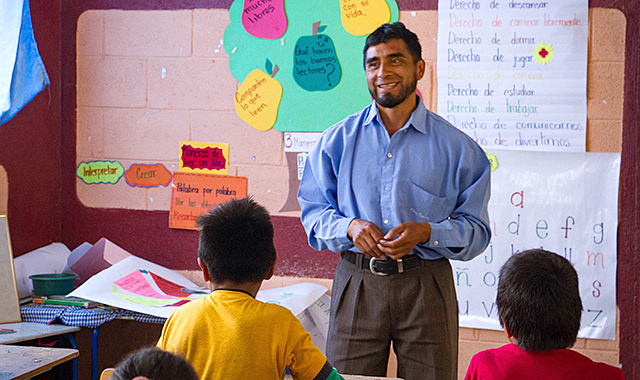
In his 14 years as a teacher and principal, Romeo Sen Quino says he’s been to lots of trainings and generally found them a waste of time. So when he attended his first Child Aid training workshop a few years ago, he came prepared.
“I usually prefer to bring something else to keep me busy,” he says, “like my phone or a newspaper to read. Because our typical trainings are boring and they just tell us things we should do.”
“But when I arrived at the Child Aid training, I immediately set those things aside. At that moment, I was so excited — I thought, ‘I’m going to learn something good, something useful.” And that’s exactly what I’m doing – learning and then putting it into practice.”
Romeo teaches 3rd and 4th grade in the rural community of Sucún and has been participating in the Reading for Life program since 2015. He says he and the seven other teachers in his school appreciate the books, practical techniques and support they have received from Child Aid. It has helped them create a new atmosphere in the school and make changes that have improved the learning environment for their students.
“In Guatemala, they tell the teacher, ‘Do this,’ but no one teaches them how. They say, ‘Here are the tools you use to teach reading,’ but no one ever teaches us how to use them. For me, this doesn’t work. They just tell us to do something and at the end they want a report of how the students have improved.”
“But with [Child Aid], it isn’t like that. We are always excited to go to the Child Aid trainings because we’re interested in learning the techniques, the strategies, the methods and all the tools that they give us. Child Aid gives us a step-by-step guide to have successful results. These are the things that are strengthening and helping us.”

Romeo has seen many positive changes in his students, especially in their enthusiasm for reading.
“It’s no longer necessary to obligate them to read,” he says. “Before, the students weren’t interested in reading, because for one, we didn’t have any interesting books. But since Child Aid has come, now we have a lot of great books that are about movies that the kids have already seen on TV – like Spiderman – and they are excited to read because they are already familiar with the stories. In the classrooms, when the students arrive in the morning, they don’t just sit down. They go straight for the books to find something to look at.
“There are a lot of books that allow them to relate what they do [in their lives] to what they see in the books. They say, ‘Teacher, I did this and now I see it in this book!’ or ‘I saw this book and then I went to try it myself!’ They’ve done it before or they read something in a book and then they go to do it in their own lives. These are great experiences when the kids do that.”
Romeo says his experiences with Child Aid have changed his own attitude toward learning and teaching. He is bringing books home to share and read with his young son and daughter. He and the other teachers in his school have started a monthly reading club to discuss the books they’ve read and the connections they’ve found with their own lives and experiences. And he says he has learned to adapt his approach to teaching so that all his students can participate in the learning process.
“I always tell them that we are learning together. I say that I am a child, too, and every day I come to be able to learn with them. The kids are happy because we teachers feel like a part of them. We don’t come as bigger and better than them, but rather when we come to class, we are students as well.”